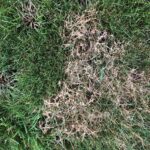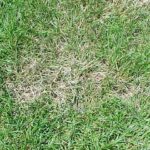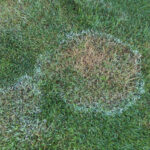Table of Contents
ToggleLast Updated on May 2, 2025
Early Drought Stress
After a great start to the spring, there was a surprise drought during the month of May. The overall precipitation was 2 inches under the average for the month. After the summer drought of 2022, the last thing anyone wanted to see was more drought stressed turf just before the start of the summer.
The heat stress meant adjusting cultural practices accordingly. Lawn mowing, typically done every 5-7 days, was able to be stretched to every 10-14 days by the end of the month. We saw an increase in mower traffic stress on lawns where scheduling adjustments weren’t made soon enough.
We always recommend an irrigation schedule that will provide heavy, infrequent watering to the lawn. This means running the irrigation for about 1-2 hours per zone, once every 3-5 days. Despite our recommendations, most homeowners disregard them in the late part of the spring and can keep their lawns green with the typical irrigation setting of 20 minutes per zone run every other day. Without additional rainfall to supplement the light watering, the grass was looking very stressed. Pictured below are the green spots that could be seen in areas immediately surrounding each sprinkler head. In these areas, within 6 to 12 inches of the sprinkler head, the droplets are large enough to penetrate the root zone, keeping the grass green. The grass further away from heads, where the lawn is getting coverage from much smaller droplets that evaporate before being able to benefit the lawn, are brown. Homeowners were not happy paying their inflated water bill while staring at a brown lawn, especially when the solution to the problem was to water even more.
Early drought also meant that the grass types established in the lawn that thrive in cooler, wetter weather generally provided at this time, were already going into summer dormancy. Grass types such as red fescue, chewings fescue, bentgrass, poa trivialis, and annual bluegrass had all turned brown. Once these grasses go into dormancy, the plants use all their moisture and carbohydrates to keep the crown and roots (most vital plant parts) alive. This means that the plants will not turn green with a treatment. The color will only return once the cooler, wetter weather returns, and that usually means summer’s end.
Disease
Red Thread
If there was a silver lining at all to the May drought, it was the effect on red thread. Red thread is more widespread during cooler, wetter spring months. However, with no frequent rainfall keeping the lawn surface wet through the night, there was less red thread than usual observed through May and June.
Dollar Spot
By June, most homeowners with irrigation were starting to water more in the hopes of reversing the effects of the May drought. Those who changed to a deeper, less frequent watering schedule were rewarded for their efforts with the lawn returning to form. Those who did nothing or watered more frequently at the same 20 minutes per zone, saw little to no improvement and perhaps worse still, a lot of dollar spot activity. Dollar spot thrives in turf that is stressed and where soil surfaces remain moist. The weather in May provided the stress and the frequent, light watering provided the shallow soil surface moisture needed to trigger dollar spot outbreak.
Brown Patch
In July we saw rainfall return with totals for the month reaching 2” above average. The eventual effect was very positive and by the end of July most lawns had started to green up nicely. Initially however, the soil moisture combined with stressed plants and humid nights meant a lot of brown patch. While typically more subtle in residential lawns, the outbreaks observed were very apparent discolored portions of turf ringed with mycelium. Once lawns were treated with fungicides and irrigation was adjusted, the lawns were able to recover.
Seeding
With average rainfall returning in August and rainfall 3” above average in September, recovery of established turf from summer stress was exceptionally good. Those who felt compelled to seed also had very beneficial weather conditions if they addressed the seeding in the recommended mid-August through September window. The reasonable soil moisture in August meant that lawns could be aerated, slit-seeded, or dethatched with little difficulty. With the seed in place, heavy rainfall throughout September promoted the new growth extremely well and areas of desirable turf were established with relative ease.
October and November on the other hand have been drier than normal with rainfall being a few inches less than normal. This means that any seeding which was put off until early October must have received considerably more attention to germinate. In addition, there was a fair amount of frost in November which would have drastically slowed the development of any new plants. Any sections of lawn addressed later in fall this year should be re-evaluated in early spring 2024 to see if further touch up seeding is needed.
Conclusion
Despite the hiccup of the May drought, 2023 was a good year for maintaining or re-establishing grass. The mild summer following the stress of the previous year’s drought was much needed. Hopefully we get similar weather patterns, other than the drought in May, in the 2024 season!





